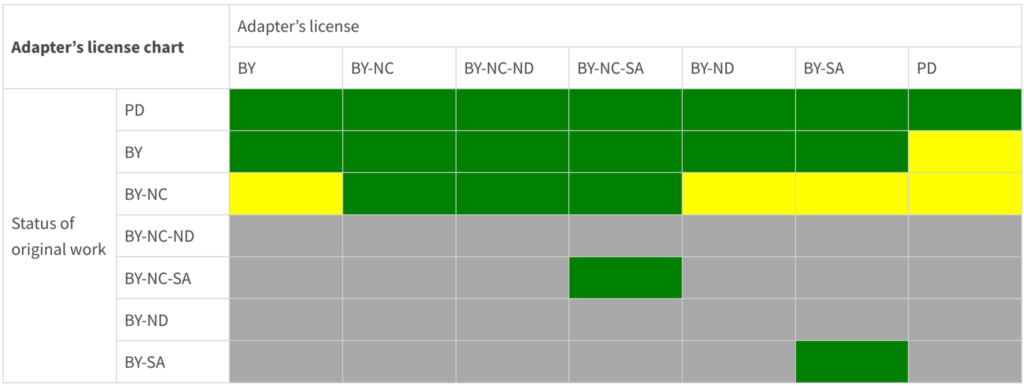The creators of original works typically hold the copyright to their work, which means that they have the exclusive legal right to publish, copy, distribute, and sell their work. Creative Commons (CC) licenses enable copyright holders to communicate how others can use their work. CC-licensed work is still under copyright, but it can legally be used, distributed, and in many cases adapted, depending on the specific terms of the license. Open licenses like CC licenses make OER possible because they enable copyrighted work to be shared, adapted, and redistributed in a vibrant knowledge commons.
CC Licenses
Each of the six CC licenses specifies how users may attribute, share, and/or use the CC-licensed work. Each license involves a combination of one or more of the following four requirements.

Attribution, or BY: This requirement specifies that credit must be given to the creator of the work. All CC licenses require attribution.

Share Alike, or SA: This requirement specifies that adaptations of the work must be shared under the same terms as the original work.

Non-Commercial, or NC: This requirement specifies that the work may be used only for non-commercial purposes.

No Derivatives, or ND: This requirement specifies that no derivatives or adaptations of the work are permitted. Because adaptations are not permitted, resources that include ND in their license are technically not OER.
In the image below, the six licenses and the Creative Commons Public Domain designation are arranged in a spectrum that shows the relative freedom allowed by each license as well as which licenses indicate works that are not OER (CC BY-ND and CC BY-NC-ND).

Learn more about Creative Commons and explore FAQ about the licensing system.
Adopting and Adapting CC-licensed Work
The CC license on a work tells you how you may use it.
- You may share a work with a CC BY-ND 4.0 or CC BY-NC-ND 4.0 as is, but you may not adapt or create derivatives of it.
- You may adapt or create derivatives of a work with a CC BY-SA 4.0 or CC BY-NC-SA 4.0 license, but you then must apply the same license to your creation incorporating that work.
- You may use a work with the CC BY-NC 4.0, CC BY-NC-SA 4.0, or CC BY-NC-ND 4.0 license only for noncommercial use.
- The CC BY 4.0 license is the least restrictive. It requires only that you give credit to the creator of the original work.
Attribution
As noted above, all CC licenses require you to give credit to the creator of the original work. Refer to the best practices for attribution at the CC Wiki and Open Washington’s Open Attribution Builder to ensure proper attribution when using CC-licensed materials. Also see our page on attribution for additional resources.
The Compatibility of CC Licenses
What if you are combining work from different sources and with different CC licenses? This chart explains the compatibility of different CC licenses. CC BY-ND and CC BY-NC-ND licenses, for example, are incompatible with any other licenses, because they do not allow for adaptation or remixing. Refer to the page on remixing and compatibility at WikiEducator for a thorough discussion of the matter.

Choosing a CC License for Your Work
Sharing your original academic or creative work with a CC license helps to grow the knowledge commons. As explained above, using a CC license does not mean giving up your copyright! CC licenses work with copyright; they do not replace it. As the organization Creative Commons explains, the licenses “let you grant additional permissions to the public, allowing reuse on the terms best suited to your needs while reserving some rights for yourself.”
Take care to think about which CC license best suits your work; once applied, a CC license is irrevocable. To help you think through your options, Creative Commons has created a license chooser.
Choosing a CC License for an Adaptation
If the work you are licensing is an adaptation of CC-licensed work, the license you choose must be compatible with the license on the work you adapted. In the chart below, find the license for the original work in the left column and the license you want to use in the top row. If the cell where the corresponding column and row intersect is green, then you can use the license you chose. If the cell where the corresponding column and row intersect is yellow, then you can use the license you chose, but it is not recommended. If the cell where the corresponding column and row intersect is gray, then you need to choose a different license.

